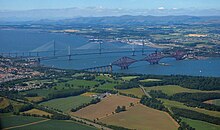Portal:Edinburgh
The Edinburgh Portal
Welcome! — Fàilte! — Walcome!
Edinburgh (/ˈɛdɪnbərə/ ⓘ Scots: [ˈɛdɪnbʌrə]; Scottish Gaelic: Dùn Èideann [ˌt̪un ˈeːtʲən̪ˠ]) is the capital city of Scotland and one of its 32 council areas. The city is located in south-east Scotland, and is bounded to the north by the Firth of Forth estuary and to the south by the Pentland Hills. Edinburgh had a population of 506,520 in mid-2020, making it the second-most populous city in Scotland and the seventh-most populous in the United Kingdom. The wider metropolitan area has a population of 912,490.
Recognised as the capital of Scotland since at least the 15th century, Edinburgh is the seat of the Scottish Government, the Scottish Parliament, the highest courts in Scotland, and the Palace of Holyroodhouse, the official residence of the British monarch in Scotland. It is also the annual venue of the General Assembly of the Church of Scotland. The city has long been a centre of education, particularly in the fields of medicine, Scottish law, literature, philosophy, the sciences and engineering. The University of Edinburgh, founded in 1582 and now one of three in the city, is considered one of the best research institutions in the world. It is the second-largest financial centre in the United Kingdom, the fourth largest in Europe, and the thirteenth largest internationally.
The city is a cultural centre, and is the home of institutions including the National Museum of Scotland, the National Library of Scotland and the Scottish National Gallery. The city is also known for the Edinburgh International Festival and the Fringe, the latter being the world's largest annual international arts festival. Historic sites in Edinburgh include Edinburgh Castle, the Palace of Holyroodhouse, the churches of St. Giles, Greyfriars and the Canongate, and the extensive Georgian New Town built in the 18th/19th centuries. Edinburgh's Old Town and New Town together are listed as a UNESCO World Heritage Site, which has been managed by Edinburgh World Heritage since 1999. The city's historical and cultural attractions have made it the UK's second-most visited tourist destination, attracting 4.9 million visits, including 2.4 million from overseas in 2018. (Full article...)
Selected location article

The Edinburgh Vaults or South Bridge Vaults are a series of chambers formed in the nineteen arches of the South Bridge in Edinburgh, Scotland, was part of the South Bridge Act 1785 and was completed in 1788. For around 30 years, the vaults were used to house taverns, workshops for cobblers and other tradesmen, as well as storage space for said merchants. In later years, the vaults were a hotspot for the homeless and for criminal activity such as illegal gambling taverns, illegal whisky distillery and, according to rumour, bodysnatchers stored corpses there overnight. There is however no proof that the serial killers Burke and Hare ever used the vaults.
As the conditions in the vaults deteriorated, mainly because of damp and poor air quality, the businesses left in the 1820s and the very poorest of Edinburgh's citizens moved in, though by around 1860, even they are believed to have left too. That people had lived there was only discovered in 1985 during an excavation, when middens were found containing toys, medicine bottles, plates, and other signs of human habitation. (Full article...)
Selected images
Selected transportation article
The Union Canal was opened in 1822 and provides an inland waterway link from Edinburgh to Falkirk and from there to Glasgow via the Forth and Clyde Canal. It is currently owned by the public corporation Scottish Canals and chiefly used for leisure purposes. (Full article...)
Selected area article
Broughton (/ˈbroʊtən/) is an ancient feudal barony, today an area of Edinburgh, Scotland. (Full article...)
Selected environment article
The Firth of Forth (Scottish Gaelic: Linne Foirthe) is the estuary, or firth, of several Scottish rivers including the River Forth. It meets the North Sea with Fife on the north coast and Lothian on the south. (Full article...)
Did you know?
- ... that George Parks was president of the Royal College of Surgeons in Ireland and his son Rowan Parks became president of the Royal College of Surgeons of Edinburgh?
- ... that Prince Philip was the first member of the British royal family to fly in a helicopter?
Selected arts article

James Grant (1822–1887) was a Scottish novelist and miscellaneous writer.
Grant was born in Edinburgh, Scotland, and was a distant relation of Sir Walter Scott. He was a prolific author, writing some 90 books, including many yellow-backs. Titles included Adventures of an Aide-De-Camp, One of "The Six Hundred", The Scottish Musketeers and The Scottish Cavalier. (Full article...)
Selected education article
List of schools in Edinburgh is a list of schools in the City of Edinburgh council area of Scotland. It lists schools both within Edinburgh itself, and in outlying villages within the local government boundary. (Full article...)
Selected sports article
Selected religion article
The Archdiocese of Saint Andrews & Edinburgh (Latin: Archidioecesis Sancti Andreae et Edimburgensis) is an archdiocese of the Latin Church of the Catholic Church in Scotland. It is the metropolitan see of the province of Saint Andrews and Edinburgh, consisting of the additional suffragan sees of Aberdeen, Argyll and the Isles, Dunkeld, and Galloway. The archdiocese is led by Archbishop Leo Cushley, and its cathedral is St Mary's Cathedral, Edinburgh. (Full article...)
Related portals
In the news
No recent news
Associated Wikimedia
The following Wikimedia Foundation sister projects provide more on this subject:
-
Commons
Free media repository -
Wikibooks
Free textbooks and manuals -
Wikidata
Free knowledge base -
Wikinews
Free-content news -
Wikiquote
Collection of quotations -
Wikisource
Free-content library -
Wikiversity
Free learning tools -
Wikivoyage
Free travel guide -
Wiktionary
Dictionary and thesaurus



























































